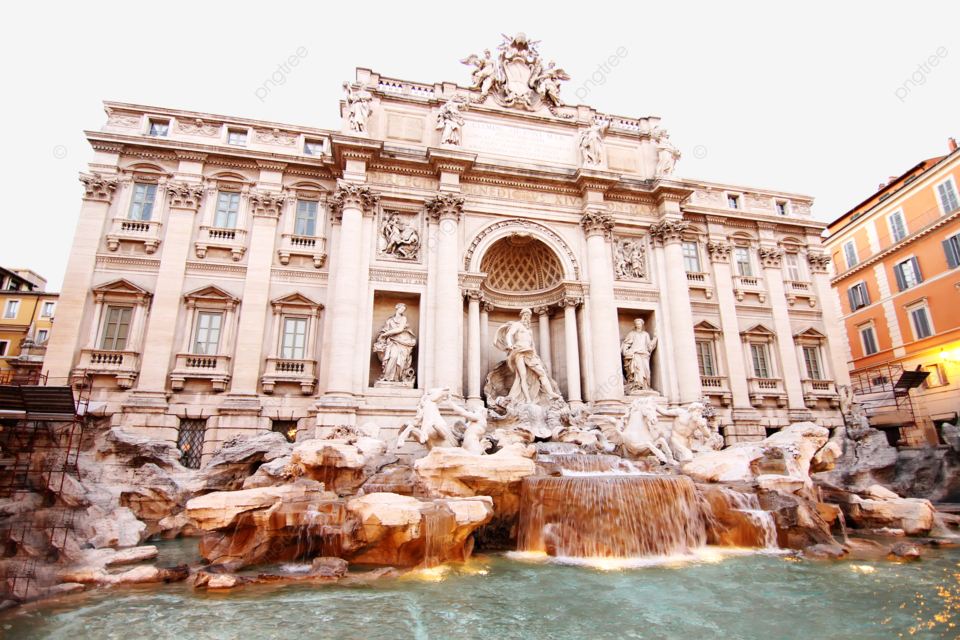The Trevi Fountain: Rome’s Iconic Gem
The Trevi Fountain, one of Rome’s most iconic and captivating landmarks, draws visitors from around the world with its grandeur, beauty, and timeless legend. Located in the heart of the city, this fountain has become more than just a tourist stop; it’s a symbol of Rome’s rich history, art, and culture. Let’s dive into what makes the Trevi Fountain an unforgettable experience.
A Masterpiece of Baroque Art
The Trevi Fountain is not only the largest Baroque fountain in Rome but also one of the most intricately detailed. Completed in 1762, this masterpiece was designed by architect Nicola Salvi and later finished by Giuseppe Pannini. At nearly 26 meters high and 49 meters wide, the fountain depicts a grand scene of Neptune, the god of the sea, surrounded by Tritons taming seahorses. Each figure and detail is meticulously crafted to capture the movement and dynamism of water—a hallmark of Baroque art.
The fountain’s theatrical design uses the Palazzo Poli as its dramatic backdrop, making it look almost like a stage set. Water cascades down from the central figure of Neptune into a large pool, symbolizing the taming of nature through human artistry. The intricate sculptures and flowing water create a breathtaking sight, especially when illuminated at night.
The Legend of the Coin Toss
Perhaps the most famous ritual associated with the Trevi Fountain is the coin toss. Legend has it that if you throw a coin over your left shoulder with your right hand, you are destined to return to Rome. This tradition has become so popular that an estimated 3,000 euros are thrown into the fountain daily! The money collected goes toward local charities, making this ritual a way to give back to the city.
For a bit of added romance, some visitors throw two coins to find love, or even three coins to ensure marriage. Whether you believe in the legend or not, the coin toss has become a must-do for many visitors, adding a bit of magic to every visit.
History and Restoration
The origins of the Trevi Fountain can be traced back to ancient Rome, when Emperor Augustus commissioned an aqueduct to bring fresh water into the city. Known as the Aqua Virgo, this aqueduct served Rome for centuries, including supplying water for the Trevi Fountain itself. When Pope Urban VIII decided to redesign the fountain in the 17th century, he turned to artist Gian Lorenzo Bernini for ideas. Although Bernini’s plans were not executed, his designs influenced the final project that Salvi brought to life a century later.
The fountain has undergone various restorations, the most recent being funded by the Italian fashion brand Fendi in 2014. This project ensured that the fountain’s sculptures, marble surfaces, and cascading water would continue to captivate visitors for generations to come.
Visiting the Trevi Fountain: Tips and Insights
- Best Time to Visit: The Trevi Fountain is particularly stunning at night, when it’s illuminated and crowds thin out. Early mornings are also a quieter time to enjoy its beauty.
- Watch for Pickpockets: As a popular tourist spot, the area around the fountain can be crowded. Keep an eye on your belongings to avoid any surprises.
- Take a Photo, but Respect the Fountain: To preserve the beauty and history of this landmark, entering the fountain or sitting on its ledges is prohibited.
- The Coin Toss Ritual: When you’re ready to toss a coin, turn your back to the fountain, hold the coin in your right hand, and throw it over your left shoulder. It’s a fun tradition that has helped make the Trevi Fountain a lasting symbol of Rome.
Final Thoughts
The Trevi Fountain stands as a testament to Rome’s ability to blend history, art, and romance. It’s not just a place to take photos; it’s a place where centuries-old legends and the hopes of modern travelers converge. So, if you find yourself in Rome, don’t miss the chance to experience the magic of the Trevi Fountain—and who knows? Your coin might just bring you back to this eternal city.


